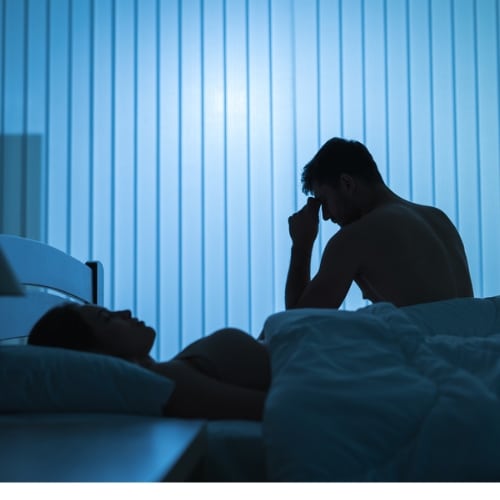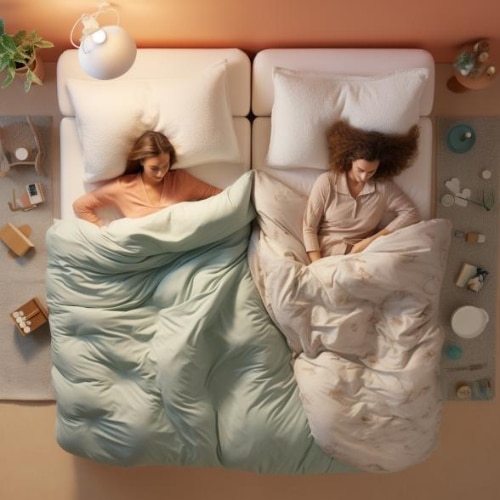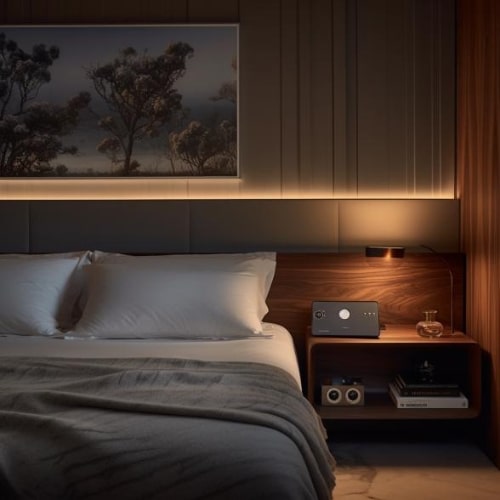Having a partner who tosses and turns in their sleep can be frustrating, especially if you are a light sleeper. It can also affect the quality of your sleep and ultimately impact your overall health and well-being. But don’t worry, there are ways to cope with this issue and still have a peaceful night’s rest together with your bed partner.
Coping with a partner’s restless sleep involves a mixture of understanding, communication, and practical solutions.
First, have an open conversation about the issue, letting them know how it affects your sleep, and see if there are steps they can take to minimize their restlessness.
Secondly, consider investing in a larger bed or a mattress designed to reduce motion transfer.
Earplugs or white noise machines can also help drown out any disruptive noise.
In severe cases, maintaining separate beds and sleeping arrangements may be beneficial. While it may seem drastic, prioritizing quality sleep is crucial for both individual and relational health.
If you’re finding it challenging to share a bed with your partner, not just due to their restlessness but for other reasons as well, our article on the difficulty of sleeping next to someone provides further insights and solutions.

The Science Behind Restless Nights
Unraveling the Causes of Restless Sleep
Restless sleep can be attributed to various factors. Stress is a common culprit, as it often leaves the mind in a state of constant alertness that can hinder the ability to fall into a deep sleep. Discomfort, either physical or environmental, can also disrupt sleep patterns. This could be an uncomfortable mattress, a too-warm room temperature, or even the presence of noise or light.
Dietary habits also play a significant role in sleep quality. Consuming caffeine or alcohol close to bedtime, for instance, can lead to restlessness. Certain medical conditions, such as sleep apnea or Restless Leg Syndrome, also lead to a lot of tossing and turning.
The Consequences of Restless Nights
The impact of restless sleep extends beyond mere tiredness. It can result in serious alterations to our REM cycles, reducing the time spent in this restorative stage of sleep. This can then lead to a slew of health complications.
Sleeping restlessly may increase the risk of mental health issues, including depression and anxiety. It can also exacerbate chronic health conditions, such as heart disease and diabetes. Overall, the importance of quality sleep should not be underestimated.
Understanding the complexities of sleep, especially the restorative nature of REM cycles, can be crucial in addressing sleep issues. For more insights, explore our article on unlocking the mysteries of REM sleep.

Signs and Symptoms of a Tossing Sleeper
Identifying Patterns: Frequency, Duration, Intensity
Recognizing the patterns of a partner who tosses and turns in sleep can be quite revealing. The key aspects to consider are frequency, duration, and intensity.
For frequency, observe how often your partner is restless during the night. Is it a constant issue or does it happen sporadically? In terms of duration, it’s important to note the length of these restless periods. Are they brief episodes or prolonged occurrences? Lastly, the intensity of the tossing and turning should also be considered. Is it subtle movement or vigorous restlessness?
Understanding these patterns can provide a better comprehension of the depth of the issue, thus informing the most suitable coping strategies.
Consequences for the Non-Tossing Partner: Interrupted Sleep, Stress
Being the partner of a restless sleeper carries its own set of challenges. The most immediate and noticeable impact is interrupted sleep. This constant disturbance can lead to sleep deprivation, impacting mental clarity, mood, and overall health.
Moreover, this situation can also lead to stress. Being regularly woken up and worrying about the lack of sleep can instigate a stress response, further hindering the ability to get a good night’s sleep. The key here is to tackle the issue head-on, with effective communication and practical solutions, to ensure both partners can achieve restful, quality sleep.
For a deeper understanding of how shared sleeping arrangements impact sleep quality, particularly in the context of psychological factors like attachment security, this study on couple sleep concordance provides valuable insights.
Addressing Underlying Causes of Restlessness
Diet and Lifestyle Factors

Impact of Caffeine, Alcohol, and Heavy Meals
Diet plays a pivotal role in determining sleep quality, particularly the intake of caffeine, alcohol, and heavy meals. Caffeine, a stimulant found in coffee, tea, and some chocolates, can interfere with the process of falling asleep and prevent deep sleep.
Similarly, while alcohol might initially induce drowsiness, it can disrupt sleep cycles and contribute to restlessness later in the night.
Heavy meals, especially when consumed close to bedtime, can lead to discomfort and indigestion, inhibiting proper restful sleep.
Improving sleep quality might also involve examining your diet. Herbal teas can be a soothing option before bed. Learn about the best teas for sleep on our blog page.
Importance of Regular Exercise and Relaxation Techniques
Regular physical activity fosters better sleep by promoting a feeling of tiredness and facilitating the transition between sleep cycles.
However, it’s essential to time it right. Engaging in vigorous exercise too close to bedtime can inadvertently lead to increased alertness, hindering the ability to fall asleep.
Relaxation techniques, on the other hand, can help prepare the body and mind for sleep. Practices like meditation, deep breathing, and progressive muscle relaxation have been found to improve sleep quality in restless sleepers by reducing stress and creating a state of relaxation conducive to sleep. Regular incorporation of these practices into daily routines can significantly improve sleep patterns and reduce nighttime restlessness.
Environmental factors like the sound of rain can also influence how quickly we fall asleep. Discover why rain makes you fall asleep faster.
Medical and Psychological Considerations
Sleep Disorders: Recognizing Restless Leg Syndrome and Sleep Apnea
Sleep disorders like Restless Leg Syndrome (RLS) and sleep apnea are common underlying causes of restlessness during sleep. RLS is characterized by an uncontrollable urge to move the legs, often accompanied by uncomfortable sensations. These symptoms can severely disrupt sleep and lead to significant restlessness.
Similarly, sleep apnea, a condition where breathing repeatedly stops and starts during sleep, can result in frequent awakenings and considerable tossing and turning. Both conditions require medical intervention for effective management. Therefore, if you or your partner suspect a sleep disorder, it is advisable to seek professional help.
The Role of Anxiety and Stress in Sleep Disturbances

Psychological factors such as anxiety and stress are closely linked to sleep disturbances. Anxiety often results in a heightened state of alertness that makes falling asleep and staying asleep challenging. It’s akin to a cycle where anxiety leads to disrupted sleep, which in turn exacerbates anxiety symptoms.
Simultaneously, stress can trigger the body’s “fight or flight” response, preventing the relaxation necessary for deep, restorative sleep. It’s crucial to address these psychological factors, as they can significantly contribute to restless sleep.
Consider seeking support from a mental health professional if anxiety or stress is impacting sleep quality. Practices such as mindfulness, cognitive-behavioral therapy, and stress management techniques can all be effective in reducing anxiety and stress levels, promoting better sleep.
If you’re curious about other nocturnal disturbances such as jaw clenching, you might find our article on jaw clenching at night informative.
Strategies to Keep Your Partner on Their Side of the Bed
Creating a Personal Sleep Zone

Implementing Physical Barriers
Creating a physical demarcation in a shared bed can help manage the issue of a tossing partner encroaching on your space. A body pillow or a partition screen can be used to effectively establish this boundary. A body pillow is long and sturdy enough to act as a barrier without causing discomfort. Its softness can provide a sense of comfort while serving the purpose of keeping your restless partner back on their side of the bed.
A folding partition screen can be used for a more rigid separation, but it needs to be handled with care to ensure it doesn’t cause any injury during sleep.
Personal Space Psychology
Establishing boundaries isn’t only about physical barriers. It also involves understanding and respecting the psychology of personal space. Communication plays a crucial role here. Have an open discussion with your partner about the need for individual sleep space.
It’s important to approach this conversation with empathy and understanding, considering the restlessness is not a conscious choice your partner makes. Establishing these boundaries and ensuring both partners understand and respect them can significantly help in maintaining personal sleep zones and promoting a better night’s sleep for bed partners.
For those contemplating whether to share a bed or sleep separately, our discussion on sleeping together versus sleeping alone offers a balanced perspective on this decision.
Behavioral Techniques for Bedtime Harmony
Pre-Sleep Routines: Meditation and Reading

Developing a pre-sleep routine can go a long way in promoting better sleep and reducing restlessness. Activities that induce relaxation and help wind down are especially beneficial. Meditation, for instance, can help clear the mind of the day’s worries, reduce anxiety, and prepare both mind and body for restful sleep. By focusing on your breathing and allowing thoughts to pass without judgment, you can achieve a state of relaxation conducive to sleep.
Similarly, reading before bed is another effective pre-sleep routine. Engaging with a good book can distract the mind from daily stresses and help transition into a state ready for sleep. However, it’s important to choose the reading material wisely. Opt for books that are relaxing and not overly stimulating or emotionally draining.
Effective Communication: Discussing Sleep Needs and Finding Compromises
Open dialogue about sleep needs and issues is essential in managing nighttime restlessness. Communicating your needs and concerns to your partner allows for mutual understanding and compromise. It’s important to approach this conversation without blame and with a focus on finding solutions that work for both parties.
For example, if your partner’s tossing and turning is due to discomfort, discussing potential causes and solutions may help. It could be as simple as adjusting the room temperature, changing the mattress or pillow, other sleeping positions or addressing any underlying health issues. Finding these compromises not only resolves the immediate issue of shared bed space but also fosters a supportive and understanding relationship.
Ever wonder why you feel sleepier when you’re around your partner? Our article explains the phenomenon behind why you might get sleepy around your partner.
Minimizing Motion Transfer for a Peaceful Sleep

Choosing the Right Mattress and Bedding
The choice of mattress can significantly impact the degree of motion transfer in a shared bed. Memory foam mattresses, for instance, are known for their ability to absorb and isolate movement due to their dense and responsive material. This characteristic makes them an excellent choice for those sharing a bed with a restless sleeper. Innerspring mattresses, on the other hand, are more prone to motion transfer due to the interconnected coils. Hybrid mattresses, which combine the supportive coils of an innerspring mattress with the motion isolation of a memory foam mattress top, can also be a good compromise.
When it comes to bedding, options such as heavy quilts or separate comforters can help manage motion transfer. Heavy quilts can dampen movement, while separate blankets or comforters allow each partner to move without disrupting the other.
Choosing the right mattress is crucial for minimizing motion transfer. If you’re considering a memory foam mattress, first read about its pros and cons in our detailed guide: Is Memory Foam Bad for Your Back?
Innovative Sleep Technologies and Accessories
Technology has also brought about innovative solutions to minimize motion transfer. One such innovation is the motion-absorbing mattress topper. These toppers, made from materials like memory foam or latex, can be placed on top of your existing mattress to absorb and isolate movement, resulting in less disturbance for the other sleeper.
Another accessory that can help is the weighted blanket. These weighted blankets use the science of pressure therapy, where deep touch pressure from the weight of the blanket helps promote a sense of calm and relaxation. This can result in less restless movement and a deeper sleep.
DIY Solutions for a Steadier Slumber
If you’re looking for more cost-effective solutions, there are also several DIY remedies to consider. For instance, mattress pads can add an extra layer of cushioning and motion absorption to your mattress. Bed bridges, which go between the two mattresses in a split bed, can help create a smooth, unified surface that minimizes the feel of movement.
Finally, the arrangement of the bed itself can impact stability. For example, placing the bed against a wall can add stability and reduce movement. However, this should be done with careful consideration for safety and ease of access.
Creating a Conducive Sleep Environment

The Role of Bedroom Ambiance
The ambiance of your bedroom plays a significant role in creating a conducive sleep environment. Lighting, temperature, and noise control are crucial elements that can influence the quality and quantity of your sleep. Dimming lights before bedtime can signal your body that it’s time to sleep, while maintaining a comfortable room temperature, usually cooler, can help induce a deeper, more restful sleep. Noise control, such as eliminating disruptive sounds or introducing calming white noise, can create a tranquil environment optimal for sleep.
In addition, aromatherapy using essential oils like lavender and chamomile can help promote relaxation and improve sleep quality. Sound machines that produce soothing nature sounds or white noise can also be beneficial in drowning out disruptive noises and setting a calming atmosphere.
The Power of Routine and Ritual
Having a consistent bedtime routine and ritual can significantly improve your sleep. Establishing a sequence of relaxing activities leading up to bedtime can signal your body that it’s time to wind down and rest. This could be reading a book, doing some light yoga, or engaging in a mindfulness meditation.
Consistency in sleep schedules is also critical. Try to go to bed and wake up at the same time every day, even on weekends. This helps regulate your body’s internal clock, also known as circadian rhythm, making it easier to fall asleep and wake up in the morning. Aligning your regular bedtime and routines with your natural circadian rhythms can lead to a more restorative sleep and a refreshed feeling upon waking.
Maintaining good sleep hygiene is crucial for couples. Discover effective strategies in our guide on sleep hygiene for couples, which can help both you and your partner enjoy a better night’s sleep.
On the flip side, if you struggle to sleep when your partner is not around, our article on why some people can’t sleep without their partner explores this dependency.
Conclusion: Embracing a Restful Night Together
Sleep is a vital aspect of our overall health and well-being, and for couples sharing a bed, it’s essential to find ways to minimize disruptions and create a peaceful environment. Effective communication, the right mattress and bedding choices, innovative sleep technologies and accessories, DIY solutions, and creating a conducive sleep environment are all key factors in achieving a restful night together. By implementing these strategies, you and your partner can both enjoy a better quality of sleep and wake up feeling refreshed and ready to take on the day together. So, embrace the challenge of sharing a bed and work towards better sleep for both of you. Sweet dreams!
